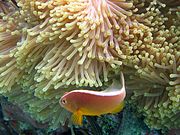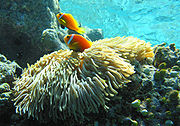ハナビラクマノミ
| ハナビラクマノミ | |||||||||||||||||||||||||||
|---|---|---|---|---|---|---|---|---|---|---|---|---|---|---|---|---|---|---|---|---|---|---|---|---|---|---|---|

| |||||||||||||||||||||||||||
| 保全状況評価[1] | |||||||||||||||||||||||||||
| LEAST CONCERN (IUCN Red List Ver.3.1 (2001)) 
| |||||||||||||||||||||||||||
| 分類 | |||||||||||||||||||||||||||
| |||||||||||||||||||||||||||
| 学名 | |||||||||||||||||||||||||||
| Amphiprion perideraion Bleeker, 1855 | |||||||||||||||||||||||||||
| 英名 | |||||||||||||||||||||||||||
| pink skunk clownfish pink anemonefish |
ハナビラクマノミ (学名:Amphiprion perideraion)は、スズメダイ科に分類される海水魚の一種。オーストラリア北部からマレー諸島、メラネシアにかけて広く分布している[2]。イソギンチャクと共生しており、触手の影響は受けない。厳密な順位制を持っており、繁殖雌が最も大きく、繁殖雄が次に大きく、非繁殖雄は順位が下がるにつれて体も小さくなる[3]。繁殖雌が死亡すると繁殖雄が性転換し、最大の非繁殖雌が繁殖雄になる[2]。
形態
[編集]体色は桃色からオレンジ色で、背中に白いラインがあり、目の後ろに白いバンドが入る[2]。クマノミ属の中では小型で、全長は10 cm程度[2]。
類似種
[編集]A. akallopisos、セジロクマノミ、A. pacificus に似るが、この3種は頭部のバンドが無い。A. nigripes にも似るが、この種は腹鰭と臀鰭が黒い。またA. leucokranosにも似るが、この種は背中のラインが途中で途切れる[2]。
-
ハナビラクマノミは背中のラインと頭部のバンドが特徴
-
A. akallopisos は頭部のバンドが無い
-
セジロクマノミも頭部のバンドが無い
-
A. leucokranos は背中のラインが途切れる
-
A. nigripes は腹鰭や臀鰭が黒い
分布と生態
[編集]マレー諸島、メラネシア、グレートバリアリーフとトンガから北は日本まで、西はココス諸島、クリスマス島、スマトラ島まで、インド洋東部から西太平洋にかけ分布する。日本では和歌山県、琉球列島、南大東島に分布[4]。潮通しの良いサンゴ礁の礁湖や斜面に生息する[4][5]。生息水深は3 - 20 mと考えられていたが、グレートバリアリーフでの調査では水深50 - 65 mの場所から発見された[6]。本種とクマノミは、クマノミ属の中でオーストラリアの東海岸と西海岸の両方で見られる種である[2]。ジャワ海の個体群は他の場所と遺伝的に隔離されている[7]。
シライトイソギンチャク、センジュイソギンチャク、マバラシライトイソギンチャク、ハタゴイソギンチャクと共生する[2][8]。縄張り意識はそこまで強くないため、他のクマノミと同じイソギンチャクに共生することもある[9][10]。卵を岩に産みつけ、鰭を用いて新鮮な海水を供給する。性格は臆病で、イソギンチャクへの依存度が高い[11]。動物プランクトン、蠕虫、尾索動物などを捕食するが、主に藻類を食べる傾向がある[2]。
人との関わり
[編集]観賞魚として飼育する目的の捕獲や、地球温暖化、海の酸性化によるイソギンチャクの減少の影響を受けている[12]。飼育下ではブラインシュリンプ、貝類、藻類など様々な餌を食べ、飼育下繁殖の例もある[10]。
沖縄県においては1998年に高温が続いたことによるシライトイソギンチャクの白化で、大きなシライトイソギンチャクを利用できなくなったハナビラクマノミが局所的に絶滅している[13][14]。
脚注
[編集]- ^ Jenkins, A.; Carpenter, K.E.; Allen, G.; Yeeting, B. & Myers, R. (2017). “Amphiprion perideraion”. IUCN Red List of Threatened Species 2017: e.T188340A1860821. doi:10.2305/IUCN.UK.2017-2.RLTS.T188340A1860821.en 2024年3月2日閲覧。.
- ^ a b c d e f g h Fautin, Daphne G.; Allen, Gerald R. (1997). Field Guide to Anemone Fishes and Their Host Sea Anemones. Western Australian Museum. ISBN 9780730983651. オリジナルの2014/10/18時点におけるアーカイブ。
- ^ Buston PM (May 2004). “Territory inheritance in clownfish”. Proc. Biol. Sci. 271 (Suppl 4): S252–4. doi:10.1098/rsbl.2003.0156. PMC 1810038. PMID 15252999.
- ^ a b 『小学館の図鑑Z 日本魚類館』314頁
- ^ “Pink Anemonefish, Amphiprion perideraion”. Fishes of Australia. 2024年3月2日閲覧。
- ^ Bridge, T.; Scott. A.; Steinberg, D. (2012). “Abundance and diversity of anemonefishes and their host sea anemones at two mesophotic sites on the Great Barrier Reef, Australia”. Coral Reefs 31 (4): 1057–1062. Bibcode: 2012CorRe..31.1057B. doi:10.1007/s00338-012-0916-x.
- ^ Dohna, T.; Timm, J.; Hamid, L.; Kochzius M. (April 2015). “Limited connectivity and a phylogeographic break characterize populations of the pink anemonefish, Amphiprion perideraion, in the Indo-Malay Archipelago: inferences from a mitochondrial and microsatellite loci”. Ecology and Evolution 5 (8): 1717–1733. Bibcode: 2015EcoEv...5.1717D. doi:10.1002/ece3.1455. PMC 4409419. PMID 25937914.
- ^ Ollerton J; McCollin D; Fautin DG; Allen GR. (2007). “Finding NEMO: nestedness engendered by mutualistic organization in anemonefish and their hosts”. Proc R Soc B Biol Sci 274 (1609): 591–598. doi:10.1098/rspb.2006.3758. PMC 1766375. PMID 17476781.
- ^ Hattori, A. (April 1995). “Coexistence of two anemonefishes, Amphiprion clarkii and A. perideraion, which utilize the same host sea anemone”. Environmental Biology of Fishes 42 (4): 345–353. Bibcode: 1995EnvBF..42..345H. doi:10.1007/BF00001464.
- ^ a b Tristan Lougher (2006). What Fish?: A Buyer's Guide to Marine Fish. Interpet Publishing. p. 19. ISBN 978-1-84286-118-9
- ^ 『クマノミ全種に会いに行く』66頁
- ^ Madduppa, H.HT.; Timm, J.; Kochzius M. (February 2014). “Interspecific, Spatial and Temporal Variability of Self-Recruitment in Anemonefishes”. PLOS ONE 9 (2): e90648. Bibcode: 2014PLoSO...990648M. doi:10.1371/journal.pone.0090648. PMC 3938785. PMID 24587406.
- ^ Akihisa Hattori (2002). “Small and large anemonefishes can coexist using the same patchy resources on a coral reef, before habitat destruction”. Journal of Animal Ecology 71: 824-831. doi:10.1046/j.1365-2656.2002.00649.x.
- ^ Jean-Paul Hobbs & Ashley J Frisch (2016年5月31日). “Saving Nemo: how climate change threatens anemonefish and their homes”. The Conversation 2024年9月21日閲覧。
参考文献
[編集]- 中坊徹次『小学館の図鑑Z 日本魚類館』小学館 ISBN 978-4-09-208311-0
- 中村庸夫『クマノミ全種に会いに行く』平凡社 ISBN 4-582-54235-2





